
Pachypodium ambongense is a species of plant in the family Apocynaceae. It was first published as a species of the genus Pachypodium in 1924 by the botanist Henri Louis Poisson.

Pachypodium baronii, the Madagascar palm or bontaka, is a flowering plant in the family Apocynaceae. It has the habit of a robust shrub with a spherical or bottle-shaped trunk. It has several cylindrical branches at the top.

Pachypodium brevicaule is a species of plant that belongs to the family Apocynaceae.
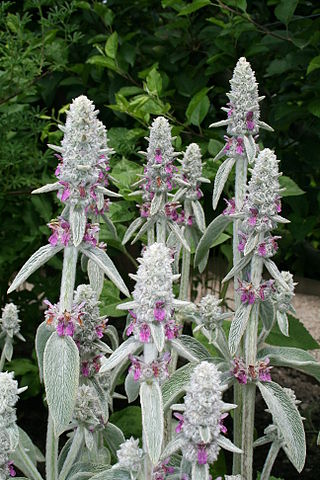
Stachys byzantina, the lamb's-ear or woolly hedgenettle, is a species of flowering plant in the mint family Lamiaceae, native to Armenia, Iran, and Turkey. It is cultivated throughout much of the temperate world as an ornamental plant, and is naturalised in some locations as an escapee from gardens. Plants are very often found under the synonym Stachys lanata or Stachys olympica.

Cinchona officinalis is a South American tree in the family Rubiaceae. It is native to wet montane forests in Colombia, Ecuador, Peru and Bolivia, between 1600–2700 meters above sea level.
Congea chinensis is a plant in the family Lamiaceae. In Chinese, it is known as 华绒苞藤.
Barbieria is a genus of flowering plants in the legume family, Fabaceae. It contains a single species, Barbieria pinnata, a climber native to the tropical Americas, from southern Mexico through Central America and the Caribbean to northern South America.

Solanum evolvuloides is a species of Solanum, which was first described in 2011 by Giacomin & Stehmann. Solanum evolvuloides belongs to section Gonatotrichum, a small group assigned to the Brevantherum clade of the genus Solanum. It resembles Solanum turneroides Chodat, sharing with it heterandry, and Solanum parcistrigosum Bitter, with which it shares a similar habit and pubescence. Despite these similarities, the species can be recognized by its ovate-elliptic to cordiform leaf shape and more membranaceous leaf texture than the other species in the section, and stem, inflorescence axes, and calyx vestiture mainly composed of glandular hairs. Solanum evolvuloides is known to occur only in southeastern of Bahia state, Brazil, and in a preliminary assessment of the International Union for Conservation of Nature (IUCN) criteria can be considered a threatened species.
Acanthopale pubescens is a species of the genus Acanthopale of the family Acanthaceae. The species occurs in East and Southern Africa. Acanthopale pubescensis also known as Herayye in Ethiopia.
Adenorandia is a monotypic genus of flowering plants in the family Rubiaceae. It was described by Vermoesen in 1922. The genus contains only one species, viz. Adenorandia kalbreyeri, which is found from west-central tropical Africa.
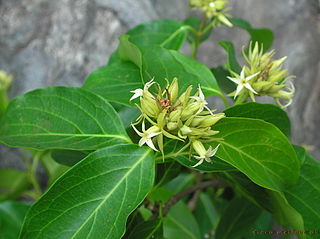
Aganosma cymosa is a liana that can grow up to 10 m (33 ft) in length, pale brownish tomentose. Leaf-stalks are 1–2 cm (0.4–0.8 in), leaf blade broadly ovate or orbicular, 5–16 cm (2.0–6.3 in) by 4–12 cm (1.6–4.7 in), base rounded or obtuse, apex acuminate or obtuse, rarely retuse, lateral veins eight to ten pairs. Flowers are borne in many-flowered clusters at branch ends, which are carried on stalks up to 6 cm (2.4 in). Bracts and bracteoles are very narrowly elliptic, about 1 cm (0.4 in) long. Flower-stalks are about 5 mm (0.2 in). Calyx with several glands inside margin of sepals; sepals very narrowly elliptic, about 1 cm (0.4 in), pubescent on both surfaces. Flowers are white, minutely tomentose outside, glabrous at throat; tube shorter than sepals, 6–7 mm (0.2–0.3 in); lobes oblong, as long as tube. Disc longer than ovary. Ovary pubescent at apex. Follicles 2, cylindric, to 30 cm (12 in) by 0.8–1.2 cm (0.3–0.5 in), yellow hirsute. Seeds oblong, 1–2 cm (0.4–0.8 in) by about 5 mm (0.2 in), coma 2–4.5 cm (0.8–1.8 in). It is native to China, Bangladesh, India, Sri Lanka, and Indochina.
Trompettia cardenasiana is a species of nightshade that is a spiny shrub bearing very small leaves, 0.35–0.5 cm (0.1–0.2 in) by 0.1–0.12 cm (0.04–0.05 in), a yellow trumpet-shaped campanulate flower, measuring about 3 cm (1.2 in) long and globose fruit. The growth habit is somewhat reminiscent of certain Lycium species. It is endemic to Bolivia, growing in dry, Andean valleys at altitudes of 2,000–2,500 m (6,600–8,200 ft) and 3,000–3,500 m (9,800–11,500 ft) and has been collected near the town of Cotagaita in Potosí Department.
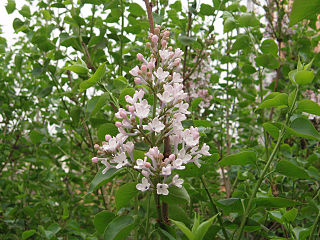
Syringa oblata is a species in the genus Syringa, in the family Oleaceae. It is also known as early blooming lilac or broadleaf lilac.
Syringa pinetorum is a species in the genus Syringa, in the family Oleaceae.
Atropa pallidiflora is a close relative of the infamous deadly nightshade and, like it, is an extremely poisonous plant, containing a variety of tropane alkaloids valued in medicine for their anticholinergic, antispasmodic and mydriatic properties and deliriant in excess. Atropa pallidiflora is the least well-known of the four currently accepted species of Atropa and is endemic to the remarkable Caspian Hyrcanian mixed forests of Northern Iran, which can boast all the species of Atropa currently recognised, with the sole exception of the strictly Ibero-Maghrebi Atropa baetica. The binomial Atropa pallidiflora was published by Eva Schönbeck-Temesy in volume 100 ('Solanaceae') of Karl Heinz Rechinger's monumental Flora Iranica in 1972. The specific name pallidiflora signifies 'bearing flowers of a pale, wan or washed-out hue' and, while appropriate, is not especially evocative, given that the flowers of most Atropa species are far from vivid. The flowers of A. pallidiflora, like those of A.baetica, vary from greenish to yellow, but, as the designation 'having pallid flowers' might suggest, the yellow in question is a dingy greenish-yellow that is far from ornamental. The geographical term 'Hyrcanian' in the common name signifies that the plant is native to what was once the satrapy of Hyrcania, the name of which derives from an Iranian root meaning 'wolf' : Hyrcania is thus the 'Land of Wolves'. The name is an apt one, since the Hyrcanian forests have long been known as a hunting ground of legendary richness and beauty : the lush forests could support an abundance of large, mammalian herbivores, which in turn could support an abundance of apex predators - notably the wolf, but also the Persian leopard and even the tiger. The word 'Hyrcanian' will be familiar to any diligent reader of the works of William Shakespeare, as an epithet of the proverbially savage Caspian Tiger, known to the dramatist from his reading of the works of various Latin authors - who, in turn, were familiar with the Ancient Greek coinage 'Hyrcania' and the lands adjoining the Caspian Sea to which the place name referred. Regarding the richness of the Hyrcanian flora - of which Atropa pallidiflora is a noteworthy element - it is worth mentioning that the name of the modern Iranian province of Golestan has the delightful meanings of 'Rose Garden' and 'Land of Flowers'.
Ampelocera hottlei is a species of neotropical trees in the Ulmaceae family.
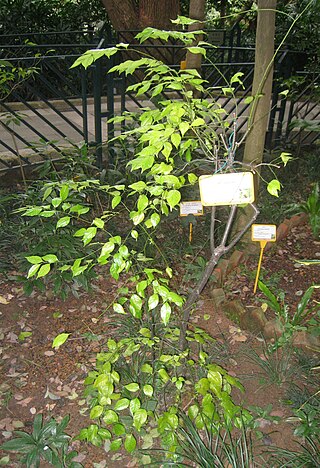
Ilex asprella, also known as rough-leaved holly and plum-leaved holly, is a deciduous shrub native in South East Asia. Ilex asprella is one of the few deciduous species in the family Aquifoliaceae.
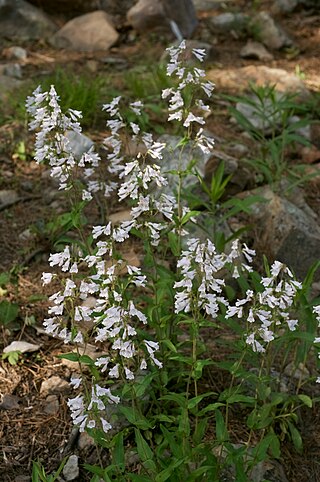
Penstemon arkansanus is a species of flowering plant in the plantain family known by the common name Arkansas beardtongue. It is endemic to Texas, Arkansas, Oklahoma, Missouri, and Illinois in the United States, occurring in rocky or sandy soils of shale or sandstone.

Prunus himalayana, called jyokun shin in Tibetan and 喜马拉雅臭樱 in Chinese, is a species of Prunus native to Nepal, Bhutan, Sikkim and Tibet. It prefers to grow 2,800 to 4,200 m above sea level in the Himalayas. As Maddenia himalaica it was the type species for the now unrecognized genus Maddenia.
Passiflora quetzal is a species of flowering plant native to Mexico and Guatemala described in 2004. It is named after the quetzal, which inhabits the area.










